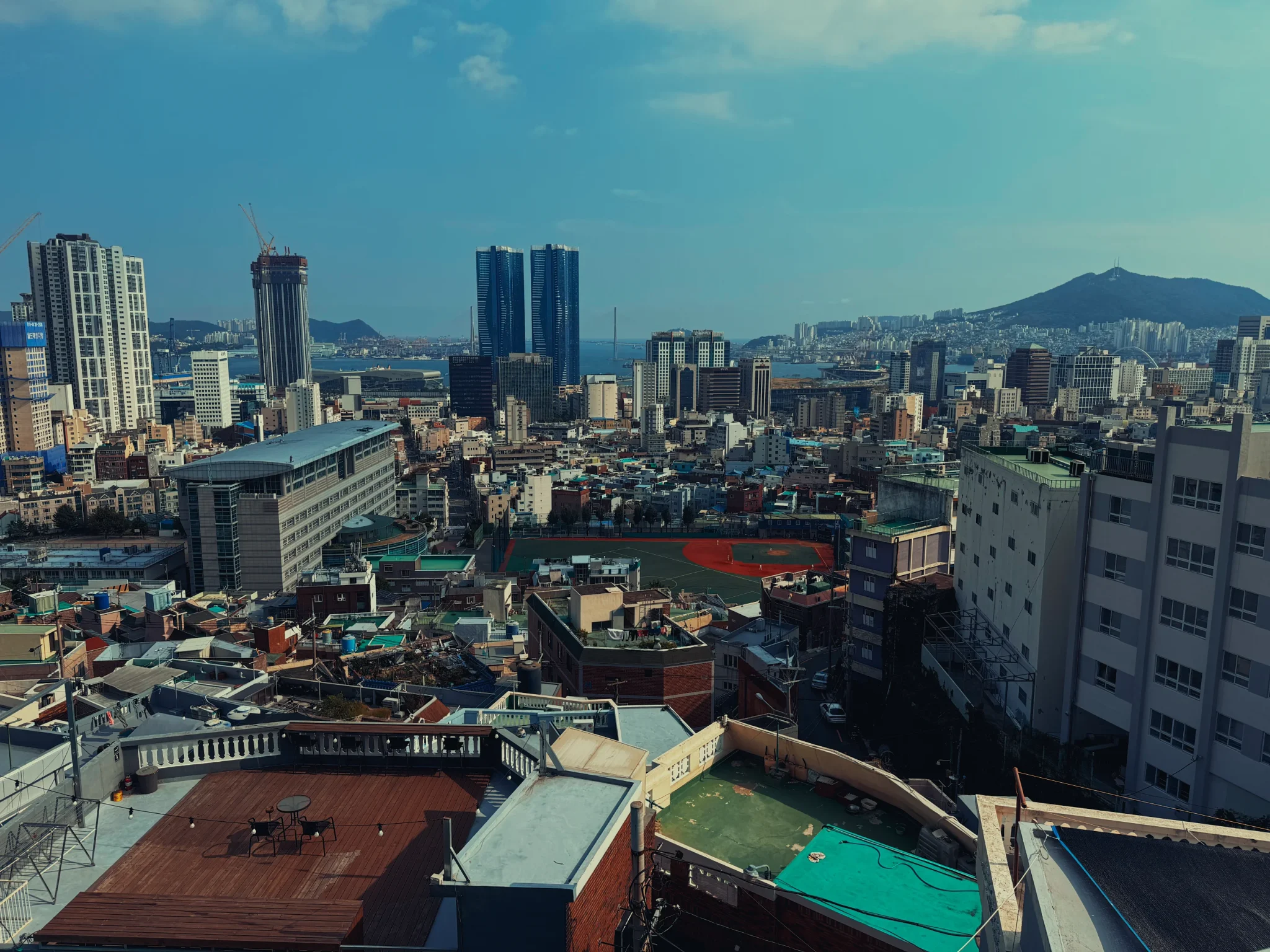In recent years, Seoul has emerged as a global leader in architectural innovation, blending tradition with modernity to create spaces that capture both Korean identity and contemporary aesthetics. As Bloomberg recently showcased, Seoul’s architects are reshaping the urban landscape with projects that reflect Korea’s cultural pride, ultimately redefining what modern architecture can mean for a nation with deep historical roots. Meanwhile, just hours away by train, Busan faces a different urban reality. Known for its vibrant coastline, mountainous topography, and neighborhoods shaped by post-war immigration, Busan’s approach to urban development has leaned heavily on high-rise apartment complexes—a solution that risks eroding its unique character. Can Busan emulate Seoul’s architectural success, revitalizing itself while preserving its identity? Here’s how Korea’s second-largest city might chart its path toward an architectural renaissance.
Seoul’s Architectural Renaissance: What’s Leading the Way
Seoul has experienced a design-driven urban evolution that has drawn attention worldwide. Projects like the Seoullo 7017 sky garden, Dongdaemun Design Plaza, and renovations of hanoks (traditional Korean houses) in neighborhoods like Bukchon are celebrated examples of Seoul’s dedication to innovation balanced with cultural preservation. Policies supporting urban renewal with a respect for history have fueled this transformation, as has a focus on sustainable, community-centered designs. Seoul’s architects are building spaces that resonate not only with the past but also embrace the future, and international recognition follows.
Busan’s Urban Redevelopment Landscape: A Tale of High-Rises and Homogeneity
In contrast, Busan’s urban redevelopment has often centered on large-scale apartment complexes, built to accommodate the influx of residents after the Korean War and continued urbanization. This approach has led to rapid housing availability but at a cultural cost. High-rise apartments have homogenized Busan’s skyline, leaving neighborhoods indistinguishable from one another and diminishing the city’s rich history. Notably, Busan has the highest concentration of high-rise apartments in South Korea. According to a 2022 report by the Ministry of Land, Infrastructure, and Transport, high-rise buildings of 30 stories or more saw a 40.4% increase in construction permits from the previous year, with 78.9% of these concentrated outside Seoul—predominantly in Busan. Among the ten tallest buildings in Korea, eight are located in Busan, including the 101-story Haeundae LCT and the 80-story Haeundae Doosan We’ve the Zenith.
While economically beneficial in the short term, this trend risks the loss of Busan’s unique character and its appeal as a historically rich city by the sea. The city’s skyline, dominated by towering apartment blocks, has begun to erode the distinctive charm and coastal heritage that once set Busan apart.
Challenges in Busan’s Current Redevelopment Strategy
Busan’s current approach to redevelopment, which relies heavily on apartment-centered developments, presents a variety of challenges that impact both the city’s identity and its residents. Rapid construction of high-rise apartments often displaces long-term residents, disrupting the social fabric and erasing connections to Busan’s historical past. The uniqueness of Busan’s architecture—marked by its hillside villages, post-war structures, and distinct maritime influences—is at risk of disappearing, as generic high-rises take their place. This approach results in a visually homogeneous skyline, making it difficult for Busan to maintain the historical nuances that set it apart and limiting its ability to stand out globally.
Pathways to an Architectural Renaissance in Busan
To cultivate a sustainable and culturally resonant future, Busan could adopt various strategies inspired by Seoul’s architectural evolution, tailoring them to the city’s coastal and mountainous environment.
One approach involves geography-sensitive, terrace-style architecture that harmonizes with Busan’s rugged topography. By designing buildings to cascade down the hillsides in a stepped layout, architects could create terrace-style structures that integrate small green spaces or communal gardens at each level. This method would enhance Busan’s natural landscape, allowing new buildings to blend seamlessly with the mountainsides and preserving the city’s scenic appeal.
Adaptive reuse of existing structures offers another avenue for revitalization. In hillside neighborhoods like Sanbokdoro, where vacant or aging homes are common, the city could forgo demolition in favor of transforming these buildings into community hubs, artist studios, or boutique businesses. This model, similar to Seoul’s success with restoring hanoks in Bukchon, demonstrates how old structures can be repurposed to breathe new life into neighborhoods, turning them into vibrant destinations that attract both residents and tourists.
Another strategy would be to incorporate culturally-infused contemporary design elements that reflect Busan’s unique identity. Seoul’s integration of traditional Korean architectural features into modern buildings shows the value of grounding new designs in cultural heritage. Busan could similarly draw inspiration from both hanok and coastal fishing village architecture, using natural materials like stone, clay, and wood to resonate with the surrounding environment. Traditional elements, such as courtyards, could be reimagined to create indoor-outdoor spaces that embrace the sea breezes and showcase the city’s ocean views.
Given Busan’s location and topography, eco-friendly and nature-oriented designs would be highly effective. The city’s proximity to the sea and its abundance of hills make it ideal for sustainable design choices like green roofing, wall greening, and rainwater harvesting systems. Incorporating nature-based solutions would allow new buildings to align visually and functionally with the environment, promoting environmental consciousness and urban sustainability. Such features could attract environmentally conscious residents and tourists, enhancing Busan’s appeal.
Community-centric development could also play a critical role in preventing resident displacement and fostering social cohesion. Following Seoul’s model of encouraging community engagement in urban planning, Busan could implement community workshops or public consultations to incorporate residents’ input in redevelopment plans. By involving locals in the design process, Busan can ensure that new developments respect the needs and values of the current residents, creating vibrant neighborhoods where locals, artists, and small businesses coexist in a culturally enriched environment.
Tourism-driven historical preservation is another promising approach for Busan, especially given its older buildings’ post-war and maritime historical significance. By converting these structures into museums, galleries, or community spaces, Busan could offer visitors a layered tourism experience that celebrates both modern and historical aspects of the city. Interpretive elements like informational plaques, guided tours, or community events could add value, transforming preserved sites into cultural learning centers and fostering appreciation for Busan’s unique past.
Finally, Busan could capitalize on its stunning coastal and mountain views by maximizing viewpoints in building designs. Architects could create large windows, balconies, and rooftop spaces that frame the coastline or mountain scenery, providing residents and visitors with unobstructed views of Busan’s natural beauty. This design choice would elevate the living experience, allowing residents to fully appreciate the city’s landscape—a quality that standardized high-rise apartments often overlook.
By adopting these strategies, Busan has the potential to foster an architectural renaissance that balances modernization with cultural preservation. Emphasizing sustainable, culturally rich, and community-focused development, Busan could emerge as a leading example of thoughtful urban transformation that respects and celebrates the unique identity of the city and its people.
Balancing Growth and Cultural Integrity
For Busan to implement these strategies effectively, a policy shift is necessary. Local government incentives for adaptive reuse, preservation grants, and tax relief for developers incorporating traditional designs could encourage a more diverse, culturally resonant urban development model. Policies must also ensure affordable housing solutions within redevelopment projects, preserving the social fabric of the community rather than displacing it.
Will Busan Rise to the Challenge?
Busan’s potential for an architectural renaissance lies in recognizing its unique assets and learning from Seoul’s successful blend of modern innovation with cultural pride. With its dramatic coastal landscapes, hillside communities, and a rich history of post-war resilience, Busan has all the elements necessary for a bold reimagining. For Busan to thrive in a globalized world, it must embrace an approach that honors its past while crafting spaces that resonate with the needs of today’s residents. The opportunity is there for Busan to emerge as a beacon of thoughtful, culturally infused urban design—and if it succeeds, the city won’t just be building for itself, but setting a new standard for architectural identity across Korea and beyond.



